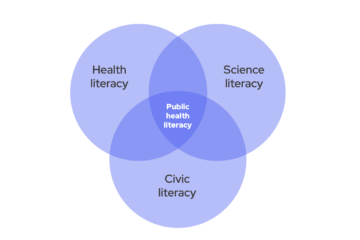
It’s helped us to design our Master of Public Health program.
As the Associate Director of the MPH program at Cornell University, my colleagues and I are charged with training and equipping the public health workforce of the future. The PH WINS data is an informative guidepost for what our program should focus on to ensure that graduates have the right skills to move into the government public health workforce.
While we haven’t yet changed our curriculum in response to the newly released 2021 data, the 2014 and 2017 data were highly informative for our program development. Our curriculum teaches and then challenges students to apply the PH WINS-related skills in real-world scenarios. We know public health workers work to address complex structural and social issues and, in our program, we mentor students to do the same. We ground them in prioritizing domains like cross-sectoral partnerships, community engagement, and the use of systems thinking in most courses across the whole curriculum. A recent review of our graduate and alumni outcomes data revealed that our alumni consistently use the PH WINS-related skills they acquired through our program, and feel they are effective in these areas as they enter the workforce.
We also find the PH WINS data to be an exciting reference point to show students the value and importance of gathering data to inform action. For example, during orientation with our newest student cohort, I was able to share some of the training needs PH WINS data revealed, saying, “If you want to be able to add real value in the public health workforce, here’s where you can focus.”
There are some 200 accredited schools and programs of public health across the country, and collectively, we can play a significant role in helping to build the government public workers’ skills capacity if we know how best to meet needs. PH WINS data helps us to build that understanding.
It informs — and enables us to assess — our training of frontline public health workers.
During the height of the COVID pandemic, we developed a partnership with the New York State Public Health Corps to provide “just in time” capacity building training to their public health fellows. Since then, we’ve developed similar partnerships with the New York State AmeriCorps program and with Cooperative Extension System offices in New York State and across the country.
So, while PH WINS data has helped shape our MPH degree program at Cornell, it has also served as a guidepost for a training designed to people serving in important frontline roles. The PH WINS data gave us workforce development goals to work towards, helping us design and deliver training focused on skills needed for success.
The Public Health Essentials Training is only an 80-hour course, so we can just skim off the top of what you might get in a degree granting program, but PH WINS makes it clear — for example — that data-based decision-making and justice, equity, diversity, and inclusion are important training areas. So, we introduce these topics right at the beginning of the course. Learners explore the drivers of inequity and articulate the importance of being able to be an effective ally and advocate. They access reliable data sources to depict and describe health disparities and inequities in their geographic area of work. Learners also develop a Rolodex of intersectoral community partners and propose effective strategies for engaging community and context experts to identify or plan interventions.
To assess the effectiveness of the training program, we’ve developed evaluation tools together with our partners, using PH WINS data as a baseline and guidepost to determine if we’re moving the needle in the right direction. Our partners in New York want to see that their employees are feeling confident in these areas so they can be effective in their efforts.
It is guiding the work of the National Consortium of Public Health Workforce Development, including highlighting the need for additional research.
Finally, PH WINS is a great resource for the work I am doing as a member of the recruitment and retention Working Group of the National Consortium for Public Health Workforce Development. We’re aiming to advance research and dialogue around improving health equity via investments in government public health workforce recruitment and retention strategies, including increased workplace satisfaction. With what is now a third cycle of PH WINS data, we are able to see trends, including by region, by area of work, and by supervisory level. These data are — and will continue to — inform the work we’re doing.
And as so often happens with research, these data have helped us articulate even more questions. For example, why have there been shifts in demographics overtime? Or for specific demographics, are we seeing gains or setbacks in terms of representation in leadership roles, or are we seeing challenges in some areas of the country? We’re keen to explore if there are other ways to parse the data to be able to answer some of these questions to inform possible actions even better.
As an educator, researcher, and advocate, I believe in the value of evidence-based decision making and appreciate having access to PH WINS data to guide me.
How are you using this cool tool?
Gen Meredith, DrPH, OTR, oversees Cornell University’s MPH Program’s curriculum design and implementation, assuring student competence development and Program accreditation. Gen was a member of the National Consortium’s Founders Committee.




